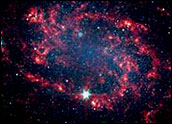
A brown dwarf is A) a tepid spot of tea; B) a tiny cup of java; or C) a star with so little energy its temperature isn’t much different from a cup of coffee or tea.
The correct answer — C — describes a newly discovered, lukewarm star about 75 light years — 709,539,630,000,000 kilometers or 440,887,486,000,000 miles — from Earth.
Wishing upon this star, however, might be difficult. Unromantically dubbed “CFBDSIR J1458+1013B,” it is the coldest and faintest star ever found, astronomers say, with a surface temperature not much higher than 100 degrees Celsius — the temperature of boiling water, or in keeping with the brown analogy, a cup of coffee or tea.
“This object has insufficient mass to become a normal star that is fusing hydrogen into helium in the core,” said Peter Gonthier, professor of physics at Hope College in Holland, Mich., who also teaches astronomy courses. Fusion is the primary process by which stars create heat and light.
Interstellar Litter
Planets are known to orbit brown dwarfs, which are not much larger than the largest planets. Brown dwarf stars top out at roughly 80 times the mass of our solar system’s largest planet, Jupiter. They are also the runts of the interstellar litter.
CFBDSIR J1458+1013B did not cool down after starting out hot like our Sun, as intuition might suggest, explained Duane Pontius, professor of physics at Birmingham-Southern College (BSC) in Alabama.
Instead, “it never became very hot in the first place because it developed from a fairly small cloud of gas,” Pontius told TechNewsWorld. “Gravity pulled the cloud together and compressed the gas, which heats it up just as a bicycle pump heats up when you compress air into a tire. But relative to brighter stars, there wasn’t as much gas, so this star never heated up much.”
Snow White and Brown Dwarf
From a distance, most visible stars look bright and snow white. But a brown dwarf wouldn’t be visible to a naked eye at all.
As their name suggests, brown dwarfs are small, dim stars without enough mass and gravitational energy to sustain hydrogen fusion reactions in their cores. In our own sun, fusion creates surface temperatures of up to 5,500 degrees Celsius, warming and lighting planet Earth.
On the other hand, “the energy in brown dwarfs comes from a slow collapse that converts gravitational energy into heat, emitted as blackbody radiation,” Hope College’s Gonthier told TechNewsWorld. As its name implies, blackbody radiation isn’t easy to detect.
Identifying a star as faint and cold as CFBDSIR J1458+1013B requires far more than the standard light-reflecting or refracting telescope. To characterize the star, astronomers at the Keck II telescope, Canada-France-Hawaii telescope, and European Southern Observatory Very Large Telescope marshaled a number of observational resources.
Regardless their brightness, “all stars emit blackbody radiation in the infrared portion of the electromagnetic spectrum. A star as cold as a cup of coffee required an infra-red measurement — in this case, using some telescopes in Chile,” Gonthier explained.
Once the star was identified, determining its unusually cool temperature involved additional energy measurements. Even a cold cup of coffee emits some energy, explained BSC’s Pontius.
“All objects emit light and other electromagnetic radiation just by virtue of having some temperature, regardless how cold or hot they are,” he told TechNewsWorld. “Studying the spectrum of that radiation lets us determine its temperature, which is what an infrared thermometer does to find your temperature without touching your skin. At body temperature, the energy we emit can’t be detected by human eyes. But we actually ‘glow’ in infrared light. A star’s light can be examined in the same way to find its temperature.”





















































